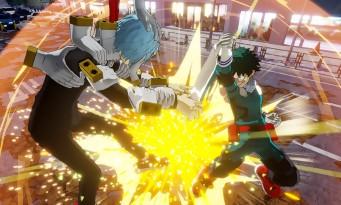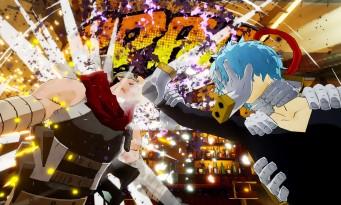 Released under the title My Hero One's Justice, this adaptation is the work of the Japanese studio Byking, a branch of the Taito company founded in 2008. It is notably responsible for arcade games only available in the Land of the Rising Sun, such as Gunslinger Stratos or Magicians Dead; these two productions are distinguished by the mixture between classic maneuverability and use of accessories, the latter allowing in particular to use a magic wand to attack with magic spells. For My Hero One's Justice, however, Byking's team returned to something more classic, but not without a few specificities. There is, for example, the usual quick attack key that allows you to perform the basic sequence by pressing it repeatedly. But by tilting the analog stick, you trigger a technique capable of absorbing an opposing attack, which allows you to interrupt an action that is a little too readable on the part of your opponent. Each character also has a guard break, whether it's a grab or an unblockable move. Each of his movements is also indicated by an aura of color which then surrounds the fighter, which makes it possible to maintain a little legibility when the action gets carried away and the camera loses the thread a little, especially when one participants start running on the walls. Those who are just waiting for the action to spin can also count on the Plus Ultra attacks, furies with effective staging available as soon as enough special gauges have been loaded. Accumulating three also allows you to launch the ultimate EX Plus Ultra attack during which the main character is then joined by the two allies who can be chosen as support from the 21 fighters available.
Released under the title My Hero One's Justice, this adaptation is the work of the Japanese studio Byking, a branch of the Taito company founded in 2008. It is notably responsible for arcade games only available in the Land of the Rising Sun, such as Gunslinger Stratos or Magicians Dead; these two productions are distinguished by the mixture between classic maneuverability and use of accessories, the latter allowing in particular to use a magic wand to attack with magic spells. For My Hero One's Justice, however, Byking's team returned to something more classic, but not without a few specificities. There is, for example, the usual quick attack key that allows you to perform the basic sequence by pressing it repeatedly. But by tilting the analog stick, you trigger a technique capable of absorbing an opposing attack, which allows you to interrupt an action that is a little too readable on the part of your opponent. Each character also has a guard break, whether it's a grab or an unblockable move. Each of his movements is also indicated by an aura of color which then surrounds the fighter, which makes it possible to maintain a little legibility when the action gets carried away and the camera loses the thread a little, especially when one participants start running on the walls. Those who are just waiting for the action to spin can also count on the Plus Ultra attacks, furies with effective staging available as soon as enough special gauges have been loaded. Accumulating three also allows you to launch the ultimate EX Plus Ultra attack during which the main character is then joined by the two allies who can be chosen as support from the 21 fighters available.
HERO OR VILLAIN?
 Thus, like its illustrious models, My Hero One's Justice does not seek to compete with so-called traditional fighting games and their more square system. But it offers fairly flexible handling and dynamic enough action to motivate fans of Japanese animation, especially since the few subtleties offer some room for improvement to give interest to the matches. Only, and it's probably the kind that wants this, faced with an inexperienced rival or on the contrary much stronger, we quickly tend to spend more time chasing after each other than fighting strictly speaking, which which can be rather boring in the long run. Fortunately, for those who cannot find a partner at the equivalent level, the game does not content itself with offering simple local or online confrontations. Indeed, two solo game modes are also available, starting with the essential Story mode. Based on the plot of the original work, the campaign is nevertheless a little disappointing: apart from a few animated sequences, the staging is static most of the time and the plot is dispatched much too quickly, which suddenly risks sure to leave newcomers on the sidelines.
Thus, like its illustrious models, My Hero One's Justice does not seek to compete with so-called traditional fighting games and their more square system. But it offers fairly flexible handling and dynamic enough action to motivate fans of Japanese animation, especially since the few subtleties offer some room for improvement to give interest to the matches. Only, and it's probably the kind that wants this, faced with an inexperienced rival or on the contrary much stronger, we quickly tend to spend more time chasing after each other than fighting strictly speaking, which which can be rather boring in the long run. Fortunately, for those who cannot find a partner at the equivalent level, the game does not content itself with offering simple local or online confrontations. Indeed, two solo game modes are also available, starting with the essential Story mode. Based on the plot of the original work, the campaign is nevertheless a little disappointing: apart from a few animated sequences, the staging is static most of the time and the plot is dispatched much too quickly, which suddenly risks sure to leave newcomers on the sidelines.
Thus, like its illustrious models, My Hero One's Justice does not seek to compete with so-called traditional fighting games and their more square system.
 This single-player campaign at least has the merit of existing and starting with a tutorial that goes over all the basics of the combat system. In addition, once this campaign is completed, we can then turn to the Mission mode. This one offers increasingly difficult series of fights against the AI and spread over different maps. We start each one by determining its team of characters that we keep throughout the course. This is also the case of the life gauge which is not automatically restored. The only solution in the event of a hard blow is then to buy one of the bonus objects, knowing that the goal of this mode is to obtain the highest score possible and that the use of these aids or, worse, a defeat, leads to a sanction at this level. If successful, you can get different accessories that you can assign to playable characters to customize their look and impress your opponents during network battles. Whether you enjoy playing solo or against other players, My Hero One's Justice therefore provides the bare minimum. It is true that it is difficult to compete with a behemoth such as Naruto Shippuden Ultimate Ninja Storm 4, which benefited from the know-how of CyberConnect2 to show a high-flying realization and above all a worked staging for its scripted campaign. . But, without being revolutionary, the production of Byking at least ensures fun and spectacle for fans of the manga signed Kohei Horikoshi, with dynamic combat and rather neat cel-shaded graphics, underlined by the partly destructible sets.
This single-player campaign at least has the merit of existing and starting with a tutorial that goes over all the basics of the combat system. In addition, once this campaign is completed, we can then turn to the Mission mode. This one offers increasingly difficult series of fights against the AI and spread over different maps. We start each one by determining its team of characters that we keep throughout the course. This is also the case of the life gauge which is not automatically restored. The only solution in the event of a hard blow is then to buy one of the bonus objects, knowing that the goal of this mode is to obtain the highest score possible and that the use of these aids or, worse, a defeat, leads to a sanction at this level. If successful, you can get different accessories that you can assign to playable characters to customize their look and impress your opponents during network battles. Whether you enjoy playing solo or against other players, My Hero One's Justice therefore provides the bare minimum. It is true that it is difficult to compete with a behemoth such as Naruto Shippuden Ultimate Ninja Storm 4, which benefited from the know-how of CyberConnect2 to show a high-flying realization and above all a worked staging for its scripted campaign. . But, without being revolutionary, the production of Byking at least ensures fun and spectacle for fans of the manga signed Kohei Horikoshi, with dynamic combat and rather neat cel-shaded graphics, underlined by the partly destructible sets.


























